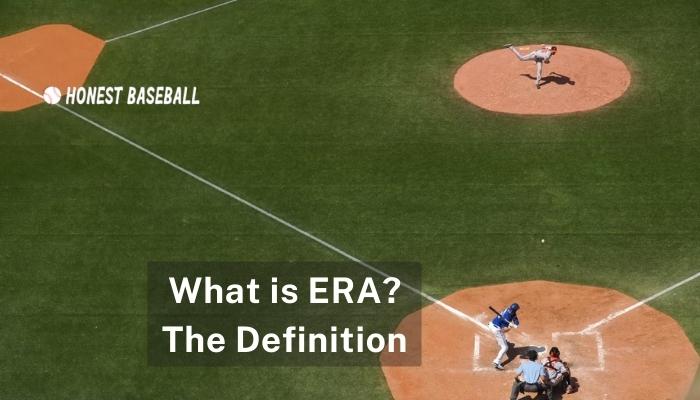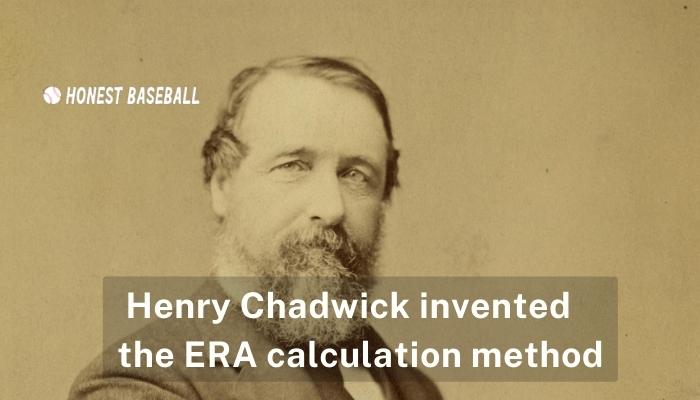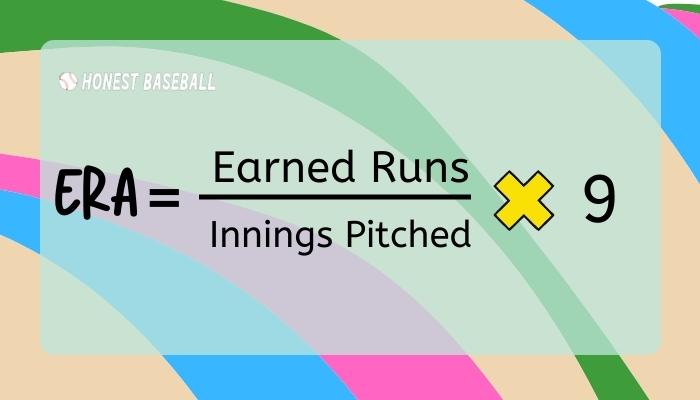An ERA is a great way to evaluate a pitcher’s performance. Earned Run Average is the full form of ERA. The elaboration shows the relation of ERA with the Earned runs.
ERA needs to be calculated based on the earned runs a pitcher gives up per nine innings.
If the question is what is a good ERA, it should be answered with several facts. But, in short, a 2.00 and below is the exceptional ERA stat, whereas 3.00 to 4.00 is a good ERA.
Summing up everything, I will discuss each little detail about ERA throughout the entire post. This explanation and detailed guide will make you understand everything about ERA and a good ERA.
So, let’s have the details and fun for a couple of minutes by diving into the deep of the post knowing the state of one of the basic skills of the game.
What is ERA Stands for?

As I mentioned before, ERA stands for Earned Run Average. Earned Run Average era is the most significant state of a pitcher. It shows how a pitcher is good or bad.
Basically, an ERA is an average of earned runs that a pitcher gives up in every nine innings pitched to the offensive team.
However, all runs scored are not earned runs. as a result, all runs also don’t go against the ERA of the pitchers. Runs could be unearned when they come from a defensive error, fielding error, or passed ball.
The earned and unearned runs in the national league need more explanation. So, let’s talk about the earned runs and unearned runs scored.
WHIP is another important statistic for evaluating a pitcher’s ability. A good pitcher must have a lower WHIP state. You might check our guide on What Does WHIP Mean in Baseball?
What Are Earned and Unearned Runs?
Earned Run
In simple words, earned run is a run that a batting or offensive team earns through right fielding. Any fielding error, defensive error, or passed ball involved in a run will not be considered an earned run.
So, the earned runs scored will affect the pitcher’s ERA calculation. Any run that is assisted by a fielding error, passed ball, or defensive error will not be counted as an earned run.
You should have understood that a lower ERA is good for a pitcher from the definition of earned runs. The lower the earned run average era, the good the pitcher is.
But, there are also ranges of ERA that are defined with different terms as well. We will discuss them in a later section.
Unearned Runs
If I am not wrong, I can expect you have already understood the definition of unearned runs. It is actually the opposite of earned runs.
Any run that comes from any fielding error, defensive error, or passed ball is called an unearned run. The main purpose of determining the unearned run is to determine which one is the pitcher’s fault and which one is not.
MLB rules show the pitcher will not be punished with the unearned runs for his state. As a result, this will also not go against the pitcher’s effectiveness.
Whether the unearned runs go against the pitcher or not, it certainly goes against the defensive team game.
When Did the ERA Come into Major League Baseball History?

Before the ERA came into the baseball game, the pitcher’s won-loss record was the only entity to determine the pitcher’s effectiveness. It was the time prior to the 1900s and by that time, the pitchers needed to pitch in a full game.
But in the 1900s, the concept of relief pitchers came into account and Henry Chadwick, an English-American sports writer came up with the ERA statistic calculation in the baseball games that perfectly shows a pitcher’s ability.
By the way, as a result, the first tabulated official earned run average era calculation was taken into account by National League in 1912. This stat was named after Heydler’s statistic after the NL secretary John Hedler.
Afterward, American League accepted the ERA statistic calculation method.
It was demanded because James Otis Crandall and Charley Hall-like pitchers began appearing in the relief pitching, making the statistic hard to calculate only by the entire game.
By the way, still, Negro League games take total runs earned for ERA calculation. Because they don’t distinguish earned and unearned runs separately.
How to Calculate ERA in a Nine Innings Pitched Game?

I hope we have a clear and concise idea about what ERA is by this time. So, it’s time to learn how to calculate these defense-independent pitching statistics for major league pitchers.
By the way, the ERA calculation has a concise method for the national league pitchers.
A pitcher’s era is calculated by dividing the earned runs he allowed by the number of innings he pitched in a season. Then, need to multiply the quotient by 9.
For example, if a pitcher pitches 50 innings in a season and gives up 20 runs, his ERA for the season will be calculated as follows.
ERA= (Total earned run/number of innings pitched)*9
In the above-mentioned case, ERA= (20/50)*9 = 3.60.
Basically, the ERA is mentioned with two decimal places.
Here, 9 is the standard length of a baseball game. In the case of the games that hold up less than nine innings, you have to consider the number of innings according to that series or standard of the game.
An FPS enhances a pitcher's confidence when he gets it with his first pitch. Do you know what it is? Let’s check the guide on “What Does FPS Mean in Baseball.”
What Is a Good ERA?
A good ERA depends on several factors. Among them, starting pitchers and relief pitchers are the two most significant terms that differ the ERA whether good or bad.
You cannot judge relief pitchers solely with the ERA stat that they should have for a starting pitcher. Conversely, the opposite is the right too.
So, the career ERA that is determined as good for the starter and the reliever is different. So, let’s get into the things and make them clear what is actually a good ERA.
What is a Good Starting Pitcher’s ERA?
So, this might be a great hassle when you need to differentiate the good ERA for starting pitchers and the relief pitchers. However, I have come up with some data so that you can understand a good ERA for a starting pitcher.
In short, you can consider a starting pitcher with a good ERA stat if he holds an ERA between 3.00 to 4.00. It’s perfectly ok and has a good ERA.
On the other hand, something under 3.00 is exceptional. If you look at the previous major league season (2021), the seasons back to the last 10 years have an ERA a whole for starting pitchers is 4.22.
According to Baseball Reference, you will get an idea of the starting pitchers’ earned run average in the following table.
| Year | Earned Runs | Earned Run Average (ERA) | Total Innings Pitched in the Season |
| 2012 | 13334 | 4.19 | 28617.2 |
| 2013 | 12770 | 4.01 | 28676.1 |
| 2014 | 12309 | 3.82 | 28992 |
| 2015 | 12844 | 4.10 | 28223.1 |
| 2016 | 13214 | 4.34 | 27412.2 |
| 2017 | 13361 | 4.49 | 26787.1 |
| 2018 | 12145 | 4.19 | 26066.2 |
| 2019 | 12689 | 4.54 | 25157.2 |
| 2020 | 4259 (Lower due to Covid outbreak) | 4.46 | 8589.2 |
| 2021 | 11765 | 4.34 | 24402.1 |
Now you know what a good ERA for starting pitcher is. Aside from this, a good ERA is subjective. By the way, I believe as a baseball fan, you might be happy to get an overall ERA rating for the starting pitchers.
| Earned Run Average (ERA) Range | Rating |
| 2.00 and below | Exceptional |
| 2.00 to 3.00 | Excellent |
| 3.00 to 4.00 | Good |
| 4.00 to 5.00 | Average |
| 5.00 to 6.00 | Below Average |
| 6.00 and above | Poor |
What is a Good ERA of a Relief Pitcher?
Now, if you think about the ERA of the relief pitchers, a good ERA will be different than the starting pitchers.
Basically, an ERA between 2.00 to 3.00 is considered a good ERA for a relief pitcher. The standard is quite lower than a starting pitcher.
But why is a lower era considered good for a reliever, whereas a higher is good for starting pitcher?
Okay, let’s clarify the thing. Basically, a relief pitcher pitches in one inning in a match. Naturally, the run he gives up should be lower than a starting pitcher. So, the main reason for differentiating the considered a good ERA for a starting pitcher and a relief pitcher is the number of innings pitched.
Let’s see the ERA rating for the relief pitchers. The following table shows the rating.
Like pitchers, fielders also get some credit with different terms. PO or PutOut is one of them. Here is our guide on “What Does PO Mean in Baseball?” for better explanation.
| Earned Run Average (ERA) Range | Rating |
| 1.00 and below | Exceptional |
| 1.00 to 2.00 | Excellent |
| 2.00 to 3.00 | Good |
| 3.00 to 4.00 | Average |
| 4.00 to 5.00 | Below Average |
| 5.00 and above | Poor |
All-Time Lowest Career Era Leader
Some players somehow get the top places, whatever, hitting or pitching. Okay, now we have a list of players with the lowest ERA. When these pitchers play, they always affect the batting average
The following table shows the 5 all-time top ERA leaders in MLB history.
| No | Player’s Name | ERA | Year Played | Team |
| 1 | Ed Walsh | 1.82 | 1904 to 1917 | Chicago White Sox (AL), Boston Braves (NL) |
| 2 | Eddie Joss | 1.89 | 1902 to 1910 | Cleveland Guardian (AL) |
| 3 | Jim Devlin | 1.89 | 1875 to 1877 | Chicago Cubs(NA), Louisville Gray(NL) |
| 4 | Jack Pfiester | 2.02 | 1903-04, and 1906-11 | Pittsburgh Pirates (NL), Chicago Cubs(NL) |
| 5 | Smoky Joe Wood | 2.03 | 190815, and 1917-22 | Boston Red Sox (AL), Cleveland Guardians(AL) |
Good ERA in High School Baseball Games
In the high school baseball lineup, the hitters get fewer hits than in collegiate baseball and Major league Baseball. So, you should remember that the high school level hitters will get less depth in their batting.
So, it is expected that the high school pitcher will get good ERA than in professional leagues.
By the way, there is no standard for considering a good or bad ERA at the high school level.
You might have known that high school baseball is generally a 7-inning game. So, the ERa calculation also takes 7 innings instead of 9 innings.
The following chart gives you an idea about a good ERA in high school baseball.
| Earned Run Average (ERA) | Rating |
| 0.00 to 0.60 | Exceptional |
| 0.60 to 1.20 | Excellent |
| 1.20 to 2.00 | Good |
| 2.00 to 3.00 | Average |
| 3.00 to 4.00 | Below Average |
| 4.00 to 5.00 and above | Poor |
Quick Notes
Single Season Lowest ERA
According to Baseball Reference, the lowest career era in a single season is held by Robert Keyes, which was 0.64 in 1944. It is based on the player who at least one innings pitched. On the other hand, for players with two hundred innings pitched, the lowest ERA in a single season was 0.96 by Dutch Leonard in 1914.
Bob Gibson holds the lowest ERA record of 1.12 in a single season among the players who pitched a minimum of 300 innings (Live ball ERA). St. Louis Cardinal’s pitcher did this in 1968.
In the current century, Los Angeles Dodgers’ Zack Greinke has the lowest ERA in a single season. He got a 1.66 ERA in 2015.
All-Time ERA Leader
Ed Walsh is the all-time best ERA holder. His career ERA is 1.82. He did it between 1904 to 1917.
By the way, players are considered all-time leaders who pitched a minimum of 1000 innings in their career.
On the other hand, as an active pitcher, Clayton Kershaw is currently holding the ERA leadership. He has a 2.44 ERA.
And Mariano Rivera is the live ball era leader with an ERA of 2.21. He did this in his career between 1995 to2013.
The Highest ERA Holder (!) in a Single Season
Not a comfortable state for the pitcher at all. The highest (worst actually!) ERA holder for all-time in a single season is Les Sweetland of the Philadelphia Phillies. He got the worst ERA at 7.71 in the 1930 season.
Because of the state of this qualified pitcher, the Phillies set the worst ERA as a team as well in that year. They finished the season with a 6.70 team ERA.
There are different baseball positions aside from pitching. A detailed guide on baseball positions will clarify your askings. Let’s check out the guide on “Positions On The Baseball Field Explained By A Coach” to understand the different positions of defensive team.
Frequently Asked Questions
Is a 7.00 ERA good?
Certainly not. Actually, a good career era is considered between 2.00 to 4.00 (starter and reliever). An ERA of 7.00 is poor. Not poor actually, it is the worst.
Is an ERA of 1 GOOD?
In the 21st century, an ERA of 3.00 to 4.00 is considered good. Bellow 3.00 is great and below 2.00 is exceptional.
Is a lower ERA better in baseball?
A lower ERA shows how lower a pitcher gives up earned runs to the hitters. That means that the lower the ERA, the good the ERA is.
What is a 0.00 ERA?
A 0.00 ERA is counted for a relief pitcher. The reliever takes the field with his side up by one run, two outs, and bases loaded. In this scenario, if the pitcher allows a single that results in two runs, the runs won’t affect his ERA.
And if he out the following batter, the game’s ERA will be 0.00 for him.
Wrapping Up
As ERA is the most important state for evaluating the pitchers, it should be as lower as possible. The lower ERA helps to get opportunities for collegiate baseball players to get opportunities in big teams and big facilities.
Even a strong ERA has a greater influence on a pitcher’s evaluation than his win-loss record. I hope now you know “what is a good ERA” and its impact.
Additional Read:
How Many Innings Are There In A Baseball Game (According To 2022)
Pitching Drills For Accuracy |More Perfection

Hello everyone. My name is Jason Butler, and I live in California, America. I was a professional AAA Minor League Baseball player. I lost my chance of playing MLB for injury issues, but I did not lose my love for baseball. I attended the coaching training program and am now working as a coach in a small school in San Diego.
I always love to share my experience and knowledge if that can help you. Play baseball, and stay fit.
